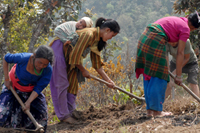|
The global economic crisis could force more girls out of education
and into child labour, experts have warned as World Day Against
Child Labour is marked globally.
More than 100 million girls are involved in child labour worldwide,
according to a report released by the International Labour
Organisation (ILO) on Friday.
"When families have to choose between educating a boy or a girl, the
girl often loses out," said Guy Thijs, the deputy regional director
for the ILO office in the Asia-Pacific.
"Many are expected to give priority to household chores or economic
activities over education and skills training."
The report, Give Girls a Chance: Tackling Child Labour, notes that
progress has been made in reducing child labour globally, but also
that the economic crisis will test commitment to
further improvements.
Dangerous work
Many girls involved in child labour undertake similar types of work
as boys, but often endure additional hardships and face extra
risks.
A major sector of employment for young girls is domestic work in
households.
In Bangladesh, an estimated two million domestic workers are
employed in the cities of Dhaka and Chittagong alone.
According to rights groups in the country, the girls often begin
working when they are eight-years old and can be subjected to
violence and sexual abuse.
The Bangladeshi Labour Institute says there are approximately eight
million children who have full or part-time jobs.
However, in a country where at least 40 per cent of the population
lives in poverty, child labour is often regarded by many as a
necessity.
The ILO has called for a "policy response" to address the causes of
child labour, such as high poverty rates in developing countries.
"Investing in girls' education is particularly important," Thijs
said.
"Putting girls into schools is one of the best investments any
country can make.
|








 I
I